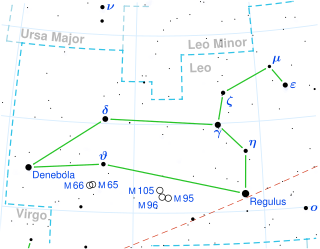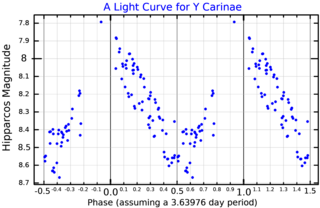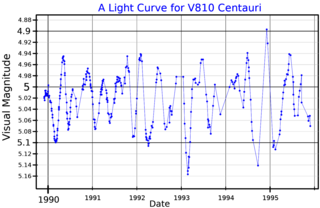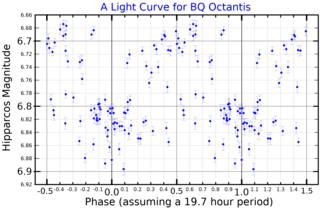
Epsilon Leonis is the fifth-brightest star in the constellation Leo, consistent with its Bayer designation Epsilon. It is known as Algenubi or Ras Elased Australis. Both names mean "the southern star of the lion's head". Australis is Latin for "southern" and Genubi is Arabic for "south".

RT Aurigae is a yellow supergiant variable star in the constellation Auriga, about 1,500 light years from Earth.

HD 84810, also known as l Carinae, is a star in the southern constellation of Carina. Its apparent magnitude varies from about 3.4 to 4.1, making it readily visible to the naked eye and one of the brightest members of Carina. Based upon parallax measurements, it is approximately 1,600 light-years from Earth.

HD 95109 is a Classical Cepheid variable, a type of variable star, in the constellation Carina. Its apparent magnitude is 6.86.

Y Carinae is a Classical Cepheid variable, a type of variable star, in the constellation Carina. Its apparent magnitude varies from 7.53 to 8.48.

V Aquilae is a carbon star and semiregular variable star in the constellation Aquila. It has an apparent magnitude which varies between 6.6 and 8.4 and is located around 400 parsecs (1,300 ly) away.

V810 Centauri is a double star consisting of a yellow hypergiant primary and blue giant secondary. It is a small amplitude variable star, entirely due to the supergiant primary which is visually over three magnitudes brighter than the secondary. It is the MK spectral standard for class G0 0-Ia.

U Aquilae is a binary star system in the constellation Aquila, Located approximately 614 parsecs (2,000 ly) away from Earth.

TX Piscium is a variable red giant star in the constellation Pisces. It is amongst the reddest naked eye stars, with a significant reddish hue when seen in binoculars. It is approximately 800 light years from Earth.

Kappa Herculis is an optical double star in the constellation of Hercules. The two components, Kappa Herculis A and B, were 27.3 arc seconds apart in 2000. Based on parallax measurements from the Hipparcos mission, κ Her A is about 113 parsecs from the Sun and κ Her B is 600 parsecs ; more recent parallax measurements suggest that B is around 5% more distant than A.

89 Herculis is a binary star system located about 4,700 light years away from the Sun in the northern constellation of Hercules. It is visible to the naked eye as a faint, fifth magnitude star. The system is moving closer to the Earth with a heliocentric radial velocity of −28.5 km/s.

Type II Cepheids are variable stars which pulsate with periods typically between 1 and 50 days. They are population II stars: old, typically metal-poor, low mass objects.

W Virginis is the prototype W Virginis variable, a subclass of the Cepheid variable stars. It is located in the constellation Virgo, and varies between magnitudes 9.46 and 10.75 over a period of approximately 17 days.

Kappa Pavonis is a variable star in the constellation Pavo. It is the brightest W Virginis variable in the sky.

BL Herculis variables are a subclass of type II Cepheids with low luminosity and mass, that have a period of less than eight days. They are pulsating stars with light curves that frequently show a bump on the descending side for stars of the shortest periods and on the ascending side for longer period stars. Like other type II Cepheids, they are very old population II stars found in the galaxy’s halo and globular clusters. Also, compared to other type II Cepheids, BL Herculis variables have shorter periods and are fainter than W Virginis variables. Pulsating stars vary in spectral class as they vary in brightness and BL Herculis variables are normally class A at their brightest and class F when most dim. When plotted on the Hertzsprung–Russell diagram they fall in-between W Virginis and RR Lyrae variables.

S Vulpeculae is a variable star located in the constellation Vulpecula. A supergiant star, it is around 382 times the diameter of the Sun.

RU Camelopardalis, or RU Cam, is a W Virginis variable in the constellation of Camelopardalis. It is also a Carbon star, which is very unusual for a Cepheid variable.

BQ Octantis is a variable star in the constellation Octans. It is an S-type star with an apparent magnitude of 6.82. It lies less than a quarter degree from the South Celestial Pole (SCP), making it the closest star to the SCP brighter than magnitude 7. While it is much nearer the pole than Polaris Australis, it is too dim to the naked eye to use as a visual reference.

U Monocerotis is a pulsating variable star and spectroscopic binary in the constellation Monoceros. The primary star is an RV Tauri variable, a cool luminous post-AGB star evolving into a white dwarf.

R Puppis is a variable star in the constellation Puppis. It is a rare yellow hypergiant and a candidate member of the open cluster NGC 2439. It is also an MK spectral standard for the class G2 0-Ia.



















